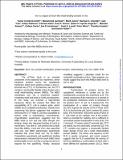Iron is a ligand of SecA-like metal-binding domains in vivo
Abstract
The ATPase SecA is an essential component of the bacterial Sec machinery, which transports proteins across the cytoplasmic membrane. Most SecA proteins contain a long C-terminal tail (CTT). In Escherichia coli, the CTT contains a structurally flexible linker domain and a small metal-binding domain (MBD). The MBD coordinates zinc via a conserved cysteine-containing motif and binds to SecB and ribosomes. In this study, we screened a high-density transposon library for mutants that affect the susceptibility of E. coli to sodium azide, which inhibits SecA-mediated translocation. Results from sequencing this library suggested that mutations removing the CTT make E. coli less susceptible to sodium azide at subinhibitory concentrations. Copurification experiments suggested that the MBD binds to iron and that azide disrupts iron binding. Azide also disrupted binding of SecA to membranes. Two other E. coli proteins that contain SecA-like MBDs, YecA and YchJ, also copurified with iron, and NMR spectroscopy experiments indicated that YecA binds iron via its MBD. Competition experiments and equilibrium binding measurements indicated that the SecA MBD binds preferentially to iron and that a conserved serine is required for this specificity. Finally, structural modelling suggested a plausible model for the octahedral coordination of iron. Taken together, our results suggest that SecA-like MBDs likely bind to iron in vivo.
Citation
Cranford-Smith , T , Jamshad , M , Jeeves , M , Chandler , R A , Yule , J , Robinson , A , Alam , F , Dunne , K A , Aponte Angarita , E H , Alanazi , M , Carter , C , Henderson , I R , Lovett , J E , Winn , P , Knowles , T & Huber , D 2020 , ' Iron is a ligand of SecA-like metal-binding domains in vivo ' , Journal of Biological Chemistry , vol. Papers in Press . https://doi.org/10.1074/jbc.RA120.012611
Publication
Journal of Biological Chemistry
Status
Peer reviewed
ISSN
0021-9258Type
Journal article
Description
Funding: JEL thanks the Royal Society for a University Research Fellowship and the Wellcome Trust for the Q-band EPR spectrometer (099149/Z/12/Z).Collections
Items in the St Andrews Research Repository are protected by copyright, with all rights reserved, unless otherwise indicated.

